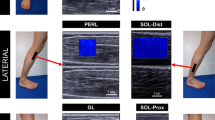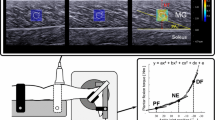Abstract
Purpose
The purpose of this study was to statistically compare the rate of torque development normalized by maximal strength (relative RTD) across ankle angles. Additionally, this study was aimed at exploring the correlation coefficients between relative RTD and passive stiffness of the medial gastrocnemius (MG) at different ankle angles.
Methods
Twenty-two healthy men and women (age: 31 ± 4 years) performed randomly-ordered explosive isometric plantar flexions at plantarflexed (15°), neutral (0°), and dorsiflexed (− 15°) angles; relative RTD comprised the slope of the time–torque curve normalized to maximal torque. The shear wave velocity (SWV; index of stiffness) of the MG at rest was measured at each angle using ultrasound shear wave elastography.
Results
The relative RTD was greater at 15° than − 15° for 0–50, 0–100, and 0–150 ms time-windows and at 15° than 0° for the 0–150 ms time-window (P < 0.05), although peak torque was lower at 15° than 0° and − 15° (P < 0.05). The relative RTD for the 0–50 ms time-window correlated with SWV at − 15° (rs = 0.475, P < 0.05), but not at 15º and 0º. Furthermore, the correlation coefficient of RTD for the 0–100 ms time-window with SWV was significantly greater at − 15° (rs = 0.420) than 0 ° (rs = − 0.109).
Conclusions
A greater relative RTD occurs at plantarflexed angles (i.e., the ascending limb of the force–length curve) in the triceps surae, and relative RTD is strongly related to passive MG stiffness at dorsiflexed angles (i.e., longer muscle lengths).


Similar content being viewed by others
Data availability
The data that support the findings of this study are available from the author upon reasonable request.
Abbreviations
- CV:
-
Coefficient of variation
- EMD:
-
Electromechanical delay
- EMG:
-
Electromyography
- MG:
-
Medial gastrocnemius
- MVC:
-
Maximal voluntary contraction
- RER:
-
Rate of electromyography rise
- RFD:
-
Rate of force development
- RMS:
-
Root mean square
- ROI:
-
Region of interest
- RTD:
-
Rate of torque development
- SOL:
-
Soleus
- SWV:
-
Shear wave velocity
References
Aagaard P, Simonsen EB, Andersen JL, Magnusson P, Dyhre-Poulsen P (2002) Increased rate of force development and neural drive of human skeletal muscle following resistance training. J Appl Physiol 93(4):1318–1326. https://doi.org/10.1152/japplphysiol.00283.2002
Ando R, Suzuki Y (2019) Positive relationship between passive muscle stiffness and rapid force production. Hum Mov Sci 66:285–291. https://doi.org/10.1016/j.humov.2019.05.002
Ando R, Sato S, Hirata N, Tanimoto H, Imaizumi N, Suzuki Y, Hirata K, Akagi R (2021a) Relationship between drop mump training-induced changes in passive plantar flexor stiffness and explosive performance. Front Physiol 12:777268. https://doi.org/10.3389/fphys.2021.777268
Ando R, Sato S, Hirata N, Tanimoto H, Imaizumi N, Suzuki Y, Hirata K, Akagi R (2021b) Relationship between resting medial gastrocnemius stiffness and drop jump performance. J Electromyogr Kinesiol 58:102549. https://doi.org/10.1016/j.jelekin.2021.102549
Blazevich AJ, Horne S, Cannavan D, Coleman DR, Aagaard P (2008) Effect of contraction mode of slow-speed resistance training on the maximum rate of force development in the human quadriceps. Muscle Nerve 38(3):1133–1146. https://doi.org/10.1002/mus.21021
Blazevich AJ, Cannavan D, Horne S, Coleman DR, Aagaard P (2009) Changes in muscle force-length properties affect the early rise of force in vivo. Muscle Nerve 39(4):512–520. https://doi.org/10.1002/mus.21259
Chino K, Takahashi H (2016) Measurement of gastrocnemius muscle elasticity by shear wave elastography: association with passive ankle joint stiffness and sex differences. Eur J Appl Physiol 116(4):823–830. https://doi.org/10.1007/s00421-016-3339-5
Cohen J (1988) Statistical power analysis for the behavioral sciences (Second Edition), 2nd edn. Routledge, Hillsdale, MI
Crotty ED, Furlong LM, Harrison AJ (2024) Neuromuscular plantar flexor performance of sprinters versus physically active individuals. Med Sci Sports Exerc 56(1):82–91. https://doi.org/10.1249/MSS.0000000000003288
de Ruiter CJ, Kooistra RD, Paalman MI, de Haan A (2004) Initial phase of maximal voluntary and electrically stimulated knee extension torque development at different knee angles. J Appl Physiol 97(5):1693–1701. https://doi.org/10.1152/japplphysiol.00230.2004
de Ruiter CJ, Busé-Pot TE, de Haan A (2008) The length dependency of maximum force development in rat medial gastrocnemius muscle in situ. Appl Physiol Nutr Metab 33(3):518–526. https://doi.org/10.1139/H08-029
Ducomps C, Mauriège P, Darche B, Combes S, Lebas F, Doutreloux JP (2003) Effects of jump training on passive mechanical stress and stiffness in rabbit skeletal muscle: role of collagen. Acta Physiol Scand 178(3):215–224. https://doi.org/10.1046/j.1365-201X.2003.01109.x
Ema R, Saito M, Ohki S, Takayama H, Yamada T, Akagi R (2016) Association between rapid force production by the plantar flexors and balance performance in elderly men and women. Age. 38(5–6):475–483. https://doi.org/10.1007/s11357-016-9949-3
Ema R, Saito I, Akagi R (2018) Neuromuscular adaptations induced by adjacent joint training. Scand J Med Sci Sports 28(3):947–960. https://doi.org/10.1111/sms.13008
Finni T, de Brito FH, Maas H (2023) Force transmission and interactions between synergistic muscles. J Biomech 152:111575. https://doi.org/10.1016/j.jbiomech.2023.111575
Folland JP, Buckthorpe MW, Hannah R (2014) Human capacity for explosive force production: neural and contractile determinants. Scand J Med Sci Sports 24(6):894–906. https://doi.org/10.1111/sms.12131
Fukunaga T, Roy RR, Shellock FG, Hodgson JA, Day MK, Lee PL, Kwong-Fu H, Edgerton VR (1992) Physiological cross-sectional area of human leg muscles based on magnetic resonance imaging. J Orthop Res 10(6):928–934. https://doi.org/10.1002/jor.1100100623
Hager R, Poulard T, Nordez A, Dorel S, Guilhem G (2020) Influence of joint angle on muscle fascicle dynamics and rate of torque development during isometric explosive contractions. J Appl Physiol 129(3):569–579. https://doi.org/10.1152/japplphysiol.00143.2019
Herbert R (1988) The passive mechanical properties of muscle and their adaptations to altered patterns of use. Aust J Physiother 34(3):141–149. https://doi.org/10.1016/S0004-9514(14)60606-1
Hirata K, Kanehisa H, Miyamoto-Mikami E, Miyamoto N (2015) Evidence for intermuscle difference in slack angle in human triceps surae. J Biomech 48(6):1210–1213. https://doi.org/10.1016/j.jbiomech.2015.01.039
Hirata K, Miyamoto-Mikami E, Kanehisa H, Miyamoto N (2016) Muscle-specific acute changes in passive stiffness of human triceps surae after stretching. Eur J Appl Physiol 116(5):911–918. https://doi.org/10.1007/s00421-016-3349-3
Janse DEJX (2003) Effects of the menstrual cycle on exercise performance. Sports Med 33(11):833–851. https://doi.org/10.2165/00007256-200333110-00004
Khowailed IA, Lee Y, Lee H (2022) Assessing the differences in muscle stiffness measured with shear wave elastography and myotonometer during the menstrual cycle in young women. Clin Physiol Funct Imaging 42(5):320–326. https://doi.org/10.1111/cpf.12763
Kubo K, Miyamoto M, Tanaka S, Maki A, Tsunoda N, Kanehisa H (2009) Muscle and tendon properties during menstrual cycle. Int J Sports Med 30(2):139–143. https://doi.org/10.1055/s-0028-1104573
Lanza MB, Balshaw TG, Folland JP (2019) Explosive strength: effect of knee-joint angle on functional, neural, and intrinsic contractile properties. Eur J Appl Physiol 119(8):1735–1746. https://doi.org/10.1007/s00421-019-04163-0
Maas H (2019) Significance of epimuscular myofascial force transmission under passive muscle conditions. J Appl Physiol 126(5):1465–1473. https://doi.org/10.1152/japplphysiol.00631.2018
Maffiuletti NA, Aagaard P, Blazevich AJ, Folland J, Tillin N, Duchateau J (2016) Rate of force development: physiological and methodological considerations. Eur J Appl Physiol 116(6):1091–1116. https://doi.org/10.1007/s00421-016-3346-6
Maganaris CN (2003) Force-length characteristics of the in vivo human gastrocnemius muscle. Clin Anat 16(3):215–223. https://doi.org/10.1002/ca.10064
Miyamoto N, Mitsukawa N, Sugisaki N, Fukunaga T, Kawakami Y (2010) Joint angle dependence of intermuscle difference in postactivation potentiation. Muscle Nerve 41(4):519–523. https://doi.org/10.1002/mus.21529
Nakamura M, Sato S, Kiyono R, Yahata K, Yoshida R, Fukaya T, Nishishita S, Knorad A (2021) Relationship between changes in passive properties and muscle strength after static stretching. J Bodyw Mov Ther 28:535–539. https://doi.org/10.1016/j.jbmt.2021.09.012
Patel TJ, Lieber RL (1997) Force transmission in skeletal muscle: from actomyosin to external tendons. Exerc Sport Sci Rev 25:321–363
Rousanoglou EN, Herzog W, Boudolos KD (2010) Moment-angle relations in the initial time of contraction. Int J Sports Med 31(9):651–655. https://doi.org/10.1055/s-0030-1255114
Silver NC, Hittner JB, May K (2004) Testing dependent correlations with nonoverlapping variables: a Monte Carlo simulation. J Exp Educ 73(1):53–69
Tillin NA, Jimenez-Reyes P, Pain MT, Folland JP (2010) Neuromuscular performance of explosive power athletes versus untrained individuals. Med Sci Sports Exerc 42(4):781–790. https://doi.org/10.1249/MSS.0b013e3181be9c7e
Tillin NA, Pain MT, Folland JP (2012) Contraction type influences the human ability to use the available torque capacity of skeletal muscle during explosive efforts. Proc Biol Sci 279(1736):2106–2115. https://doi.org/10.1098/rspb.2011.2109
Trajano GS, Seitz LB, Nosaka K, Blazevich AJ (2019) Passive muscle stretching impairs rapid force production and neuromuscular function in human plantar flexors. Eur J Appl Physiol 119(11–12):2673–2684. https://doi.org/10.1007/s00421-019-04244-0
Waugh CM, Korff T, Fath F, Blazevich AJ (2013) Rapid force production in children and adults: mechanical and neural contributions. Med Sci Sports Exerc 45(4):762–771. https://doi.org/10.1249/MSS.0b013e31827a67ba
Yamazaki K, Inoue K, Miyamoto N (2022) Passive and active muscle elasticity of medial gastrocnemius is related to performance in sprinters. Eur J Appl Physiol 122(2):447–457. https://doi.org/10.1007/s00421-021-04848-5
Acknowledgements
This study was supported in part by the Japan Society for the Promotion of Science KAKENHI grant 18K17813 and 21K17578 to RA.
Funding
Japan Society for the Promotion of Science, 18K17813, Ryosuke Ando, 21K17578, Ryosuke Ando.
Author information
Authors and Affiliations
Contributions
RA conceived and designed research. RA conducted experiments. RA analyzed data. RA wrote the manuscript.
Corresponding author
Ethics declarations
Conflict of interest
The author declare that there are no conflicts of interest.
Additional information
Communicated by Olivier Seynnes.
Publisher's Note
Springer Nature remains neutral with regard to jurisdictional claims in published maps and institutional affiliations.
Rights and permissions
Springer Nature or its licensor (e.g. a society or other partner) holds exclusive rights to this article under a publishing agreement with the author(s) or other rightsholder(s); author self-archiving of the accepted manuscript version of this article is solely governed by the terms of such publishing agreement and applicable law.
About this article
Cite this article
Ando, R. Association of the rate of torque development and joint angle with passive muscle stiffness. Eur J Appl Physiol (2024). https://doi.org/10.1007/s00421-024-05483-6
Received:
Accepted:
Published:
DOI: https://doi.org/10.1007/s00421-024-05483-6




